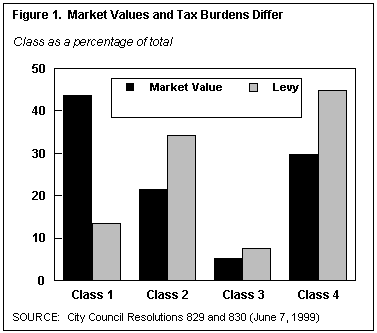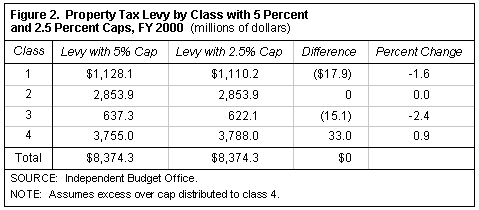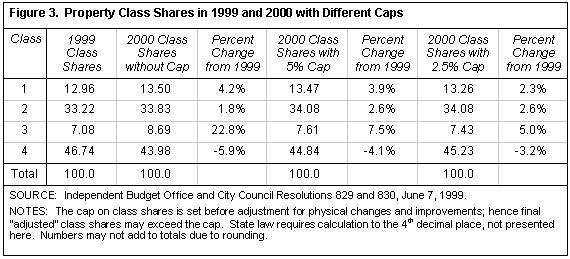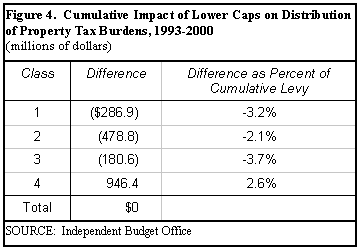
This year, as in years past, the city will seek state legislation to lower the existing cap on the allowable growth of the share of the total tax levy borne by each of the 4 classes of taxable property from 5 percent to 2.5 percent. IBO estimates that under the lower cap, commercial properties would bear an additional $33 million in property taxes (a 0.9 percent increase) in 2000, while taxes on other classes of property would fall in total by the same amount. Moreover, since 1993, commercial property owners have paid a cumulative $946 million more than they would have with a 5 percent cap.
Background. The amount of tax owed annually on real estate in New York City depends on the type of property, its value for tax purposes as calculated by the city's Department of Finance on the annual assessment roll, and the applicable tax rate.
Since 1983, the property tax has been based on four classes of taxable property: class 1, made up of one-, two-, and three-family homes; class 2, composed of apartment buildings, including cooperatives and condominiums; class 3, made up of the real property of utility companies; and class 4, consisting of all other commercial and industrial property, including office buildings, stores, factories, and vacant land.

Because assessment rates and, to a lesser extent, tax rates vary from class to class, there are wide differences between each class's share of total market value, assessed value actually subject to tax, and final tax burden (levy). As shown in Figure 1, Class 1 homes account for 44 percent of market value in the city, but only 13 percent of the tax levy. As a result, the remaining 87 percent of the total levy must be distributed onto the other three classes, which together make up only 56 percent of market value. They therefore end up bearing a disproportionately large share of the property tax burden.
Setting Class Shares. An intermediate step in getting from market value to tax levy involves setting the so-called base proportions, or class shares. Class shares are the percentage of the total tax levy borne by each class of taxable property, and are a key component in determining the final property tax burdens for homeowners, landlords, and businesses in the city. Under state law, no class's share of the total tax levy may increase by more than 5 percent in any one year. If the class share of a tax class grows by more than the 5 percent cap, the excess must be distributed among the other classes. Allocating the excess is left to the discretion of the City Council. This system was instituted in 1992 in an effort to link shifts in levy shares more closely to changes in shares of market value.
Shares are set and voted on by the City Council each Spring during the budget season. This year the vote took place on June 7th. In recent years, the city has gotten special legislation enacted in Albany allowing it to use a lower cap. Although a lower cap has no effect on total property tax revenues, it does shift tax burdens among classes. This year, the city is again seeking state legislation lowering the cap to 2.5 percent (incidentally requiring a rebilling for property taxes later in the year). IBO estimates that lowering the cap from 5 percent to 2.5 percent would result in a shift of $33.0 million in property taxes onto commercial property, or an increase of 0.9 percent in the total class 4 levy. Taxes on single-family homes (class 1) would be reduced by $17.9 million (-1.6 percent) with the lower cap, and on utility company property (class 3) by $15.1 million (-2.4 percent). The tax burden on apartment buildings (class 2) would remain unchanged (Figure 2).

The reason for this shift is that the shares of the total tax levy of property in classes 1 and 3 have both grown faster than 2.5 percent (Figure 3). As a result, with the lower cap, the excess would have to be shifted onto classes the tax shares of which have grown by less than 2.5 percent-namely, classes 2 and 4. This year, as in most years, the Council has shifted all of the excess burden onto class 4, a practice which we assume they would continue under a lower cap.

The Cumulative Effect of Lower Caps. In most years since 1993, the city has annually sought and received a lower class share growth rate than the statutory 5 percent-2 percent in 1993, 2.75 percent in 1995 and 1996, and 2.5 percent since then. Moreover, the Council has generally chosen to shift any excess under the lower caps onto class 4, commercial property.
IBO analyzed what would have happened if the Council had done two things differently over the period 1993-2000: retained the 5 percent cap, and allocated any growth above 5 percent to the other classes in proportion to their share of total market value. The results indicate that, compared to our hypothetical alternative, commercial and industrial properties have borne an additional $946 million in property taxes, equivalent to 2.6 percent of its cumulative levy (i.e., the total taxes paid over the period) under current law (see Figure 4). The other classes have all benefited to varying degrees from the lower caps: utility company property (class 3) would have paid 3.7 percent more under the alternative than it did in practice, or $181 million. Class 1 would have paid $287 million more and class 2 would have paid $479 million more.

Shifts in Market Value Are Distorted by Class Share Caps. The reason that the shifts in tax burden described above occur is relatively simple: If growth in the tax levy on any one class, measured as a percentage of the total tax levy on all classes, exceeds the cap, than those classes that grew by less than the cap must absorb some of the excess. Thus, if growth in any one class's market value would have resulted in class share growth of more than 5 percent, its share of the total levy must grow more slowly than its share of market value. And those classes whose shares of total market value grow consistently more slowly than the cap will see their shares of the levy rise faster, as they are forced to take on some of the excess.
As a result, even the 5 percent cap distorts the tax burden to some degree, since in some years a tax class's share of market value would grow by more than 5 percent. If no cap had been in place during the period 1993-2000, and if the tax levy on each class were simply based on the (uncapped) growth in that tax class's share of market value from the base year of 1990, class 4 would have paid a cumulative $1.4 billion less through fiscal year 2000, while class 3 would have paid $638 million more, class 2 $481 million more, and class 1 $252 million more.
For more information about this issue contact Preston Niblack, a senior budget and policy analyst at IBO, at (212) 442-0220.